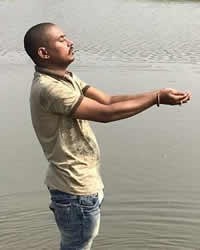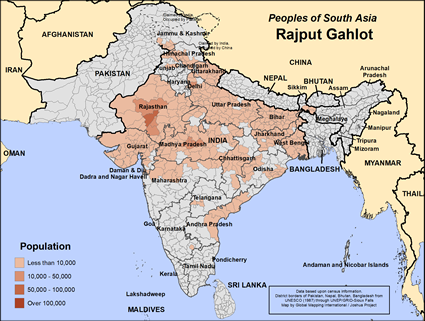Starting in the 5th century, there was a massive attack by the White Huns in what is now northern and northwestern India and Pakistan. About a century later the reigning Hindu-based Gupta Empire broke up, leaving the Subcontinent vulnerable to Muslim invaders from the north. As time went on, invaders took over land and integrated with the settled peoples of this region. Tribal leaders, especially those involved with defense, were accepted as Kshatrya, the second highest varna (major type of castes) in Hindu society, while their followers became the fourth and lowest varna. Priests became the Brahmins, the highest of the four varnas.
The Rajputs, who were part of the Kshatrya varna, became politically important in the seventh century. From around 800 Rajput dynasties ruled northern India. Petty Rajput kingdoms were the main obstacle for Muslim domination of the Hindu subcontinent. For hundreds of years Rajputs were the warriors who defended kingdoms from invaders and conquered others. Whenever possible, Rajputs settled down, became nobles, and enjoyed the lives of landed gentry.
Over a period of a couple hundred years, invaders penetrated the Rajput wall that protected the Subcontinent. Some Rajput subgroups converted to Islam during this time. The British Empire put an end to the Moghul Empire, but they recruited Rajputs into their military units. In the early 1970s Indian Prime Minister Indira Gandhi abolished Rajput titles and property rights. The Rajputs have kept alive their proud history of conquest, bravery, and military might.
Rajputs are divided by clans such as the Gahlots. The the Gahlot clan lives in both Rajasthan and Gujarat, two states in India adjacent to Pakistan.
Though Gahlot Rajputs are still in the armed forces or own land, many have moved on to other livelihoods. Wealthy Rajputs now own impressive hotels in Rajasthan where tourists can be introduced to their history and culture. Rajputs who aren't so fortunate work as small businessmen or wage laborers.
Rajputs try to marry their daughters into clans of higher rank than their own. The Rajput clans in Rajasthan have the highest status, so families want their daughters to marry men from that state. Unfortunately, Rajputs often marry their daughters off while they are very young.
Forward caste Hindus often become devotees of a couple of gods. Typically, Rajputs worship Shiva (the destroyer), Surya (the sun god), and Durga (the mother goddess). They also have patron gods to turn to for protection. They celebrate Dasahara, a festival dedicated to Durga. During this festival, they sacrifice a buffalo to celebrate this goddess' victory over a buffalo demon. To find spiritual answers, Hindus often turn to gurus.
Gahlot Rajputs are going through an identity crisis. They can no longer depend on land ownership or military careers, especially with the Indian government reserving prestigious jobs for "backward" (ie, underprivileged) castes. Believers with the right skills can help them during this time of transition.
Pray for the Hindu Gahlot Rajput community to increasingly grow in awareness of Jesus and their need for Him.
Pray the Lord will give them a spiritual hunger, then satisfy that hunger.
Pray that these Rajputs will understand the value of becoming part of God's royal family.
Pray for a Holy Spirit led humility for all Rajput communities to fall at the feet of the King of kings.
Pray for a disciple making movement among every Rajput community.
Scripture Prayers for the Rajput Gahlot (Hindu traditions) in India.
https://joshuaproject.net/people_groups/20390/IN
https://en.wikipedia.org/wiki/Gahlot
https://www.facebook.com/search/top/?q=Rajput+Gahlot&init=public
https://www.rajputmatrimony.com/gahlot-matrimonial
https://books.google.com/books?id=Cc2HyXP5dygC&pg=PA73&lpg=PA73&dq=rajput+Gahlot&source=bl&ots=yddJcW6ODt&sig=3rgiJnrsF-obikcOy7WTfKGdfXI&hl=en&sa=X&ved=0ahUKEwi9p_2mnfXRAhUN5WMKHUp5D9EQ6AEIVTAN
https://joshuaproject.net/index.php/people_groups/17928/IN
http://induhistory.blogspot.com/p/rajput-history.html
https://www.britannica.com/topic/Rajput
https://en.wikipedia.org/wiki/Rajput
| Profile Source: Keith Carey |











